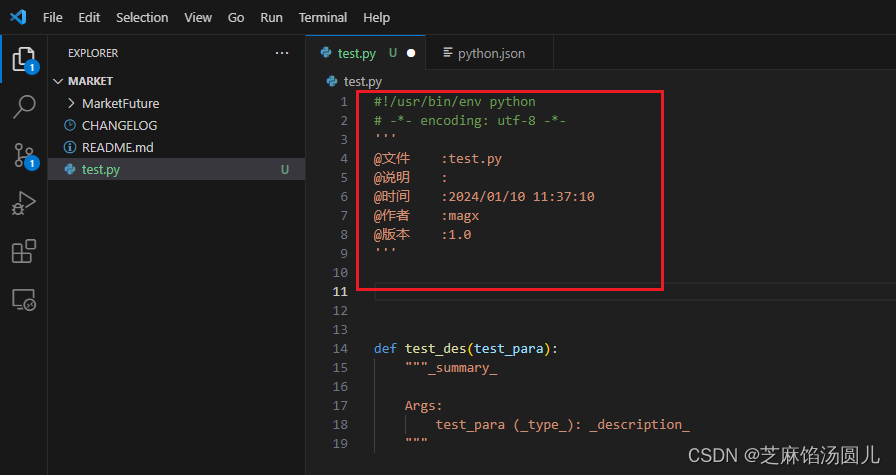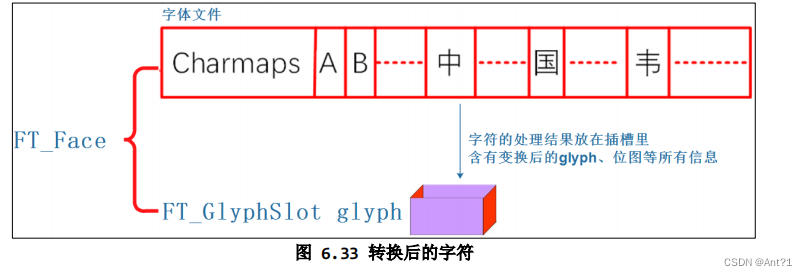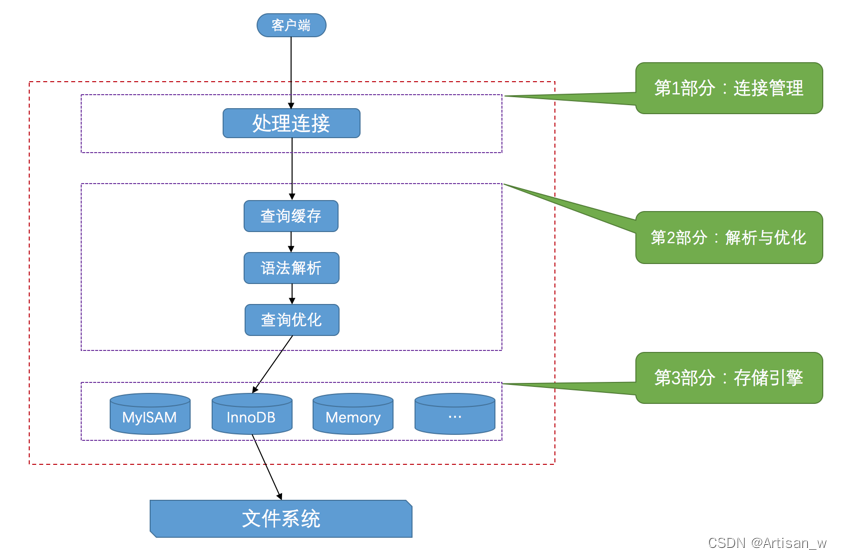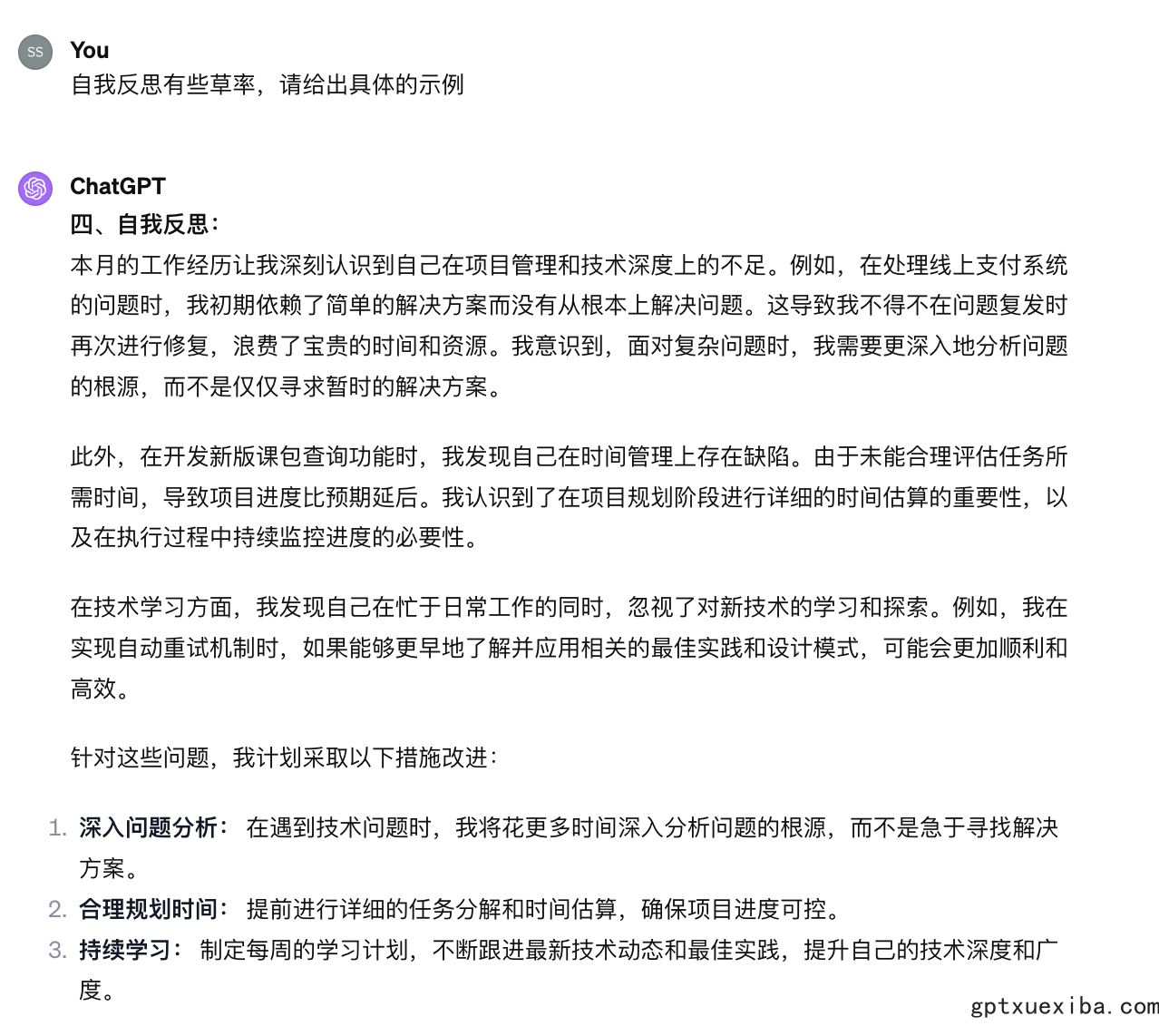Apache kafka 是一个分布式的基于push-subscribe的消息系统,它具备快速、可扩展、可持久化的特点。它现在是Apache旗下的一个开源系统,作为hadoop生态系统的一部分,被各种商业公司广泛应用。它的最大的特性就是可以实时的处理大量数据以满足各种需求场景:比如基于hadoop的批处理系统、低延迟的实时系统、storm/spark流式处理引擎。
kafka的特性:
1.高吞吐量、低延迟:kafka每秒可以处理几十万条消息,它的延迟最低只有几毫秒
2.可扩展性:kafka集群支持热扩展
3.持久性、可靠性:消息被持久化到本地磁盘,并且支持数据备份防止数据丢失
4.容错性:允许集群中节点失败(若副本数量为n,则允许n-1个节点失败)
5.高并发:支持数千个客户端同时读写
kafka是一个分布式消息系统,由linkedin使用scala编写,用作LinkedIn的活动流(Activity Stream)和运营数据处理管道(Pipeline)的基础。具有高水平扩展和高吞吐量。
Kafka和其他主流分布式消息系统的对比

1、下载安装kafka
Kafka需要依赖JAVA环境运行,需要先下载安装JDK。Kafka支持内置的Zookeeper和引用外部的Zookeeper,如果使用外部的zookeeper,需要提前下载安装zookeeper (zookeeper下载安装部署)。
在安装jdk之前,先卸载Linux系统自带的jdk。
通过 rpm -qa | grep jdk 命令查看系统自带的jdk,并通过 rpm -e --nodeps命令逐个卸载。

Jdk8下载地址:Java Downloads | Oracle

下载后上传到Linux系统的某个目录下,解压并移动到/usr/local目录下。
tar -zxvf jdk-8u391-linux-x64.tar.gz
mv jdk1.8.0_391 /usr/local/jdk1.8/jdk1.8.0_391配置环境变量,修改 /etc/profile 文件,添加如下jdk的配置。
#set java environment
export JAVA_HOME=/usr/local/jdk1.8/jdk1.8.0_391
export JRE_HOME=$JAVA_HOME/jre
export CLASSPATH=$JAVA_HOME/lib:$JRE_HOME/lib:$CLASSPATHexport PATH=$JAVA_HOME/bin:$JRE_HOME/bin:$PATH:$HOME/bin
然后执行 source /etc/profile 命令使得修改立即生效。
kafka下载地址:Apache Kafka
在/usr/local/目录下创建kafka目录,并在kafka目录下通过wget命令下载kafka压缩包,或者将在Windows系统中下载好的kafka压缩包通过Xftp传到kafka目录中,然后解压。

tar -zxvf kafka_2.12-3.6.1.tgz最后使用root用户修改/etc/profile文件,添加kafka启动bin目录,以便在任何目录下都可以通过cd $KAFKA_HOME命令进入到kafka安装目录。最后通过source /etc/profile 命令使得修改生效。
配置环境变量,修改 /etc/profile 文件,在最后加上如下配置:
export KAFKA_HOME=/usr/local/kafka/kafka_2.12-3.6.1
export PATH=$KAFKA_HOME/bin:$PATH
然后执行 source /etc/profile 命令使得修改立即生效。
2、单机部署
2.1、修改配置文件
在 /usr/local/kafka/kafka_2.12-3.6.1 目录下创建一个用于存放日志的目录mylogs,在server.properties配置文件中会使用到这个目录。
mkdir -p /usr/local/kafka/kafka_2.12-3.6.1/mylogs
修改kafka的配置文件:server.properties。
# Licensed to the Apache Software Foundation (ASF) under one or more
# contributor license agreements. See the NOTICE file distributed with
# this work for additional information regarding copyright ownership.
# The ASF licenses this file to You under the Apache License, Version 2.0
# (the "License"); you may not use this file except in compliance with
# the License. You may obtain a copy of the License at
#
# http://www.apache.org/licenses/LICENSE-2.0
#
# Unless required by applicable law or agreed to in writing, software
# distributed under the License is distributed on an "AS IS" BASIS,
# WITHOUT WARRANTIES OR CONDITIONS OF ANY KIND, either express or implied.
# See the License for the specific language governing permissions and
# limitations under the License.# see kafka.server.KafkaConfig for additional details and defaults############################# Server Basics ############################## The id of the broker. This must be set to a unique integer for each broker.
broker.id=0port=9092
host.name=192.168.10.188############################# Socket Server Settings ############################## The address the socket server listens on. It will get the value returned from
# java.net.InetAddress.getCanonicalHostName() if not configured.
# FORMAT:
# listeners = listener_name://host_name:port
# EXAMPLE:
# listeners = PLAINTEXT://your.host.name:9092
listeners=PLAINTEXT://192.168.10.188:9092# Hostname and port the broker will advertise to producers and consumers. If not set,
# it uses the value for "listeners" if configured. Otherwise, it will use the value
# returned from java.net.InetAddress.getCanonicalHostName().
#advertised.listeners=PLAINTEXT://your.host.name:9092# Maps listener names to security protocols, the default is for them to be the same. See the config documentation for more details
#listener.security.protocol.map=PLAINTEXT:PLAINTEXT,SSL:SSL,SASL_PLAINTEXT:SASL_PLAINTEXT,SASL_SSL:SASL_SSL# The number of threads that the server uses for receiving requests from the network and sending responses to the network
num.network.threads=3# The number of threads that the server uses for processing requests, which may include disk I/O
num.io.threads=8# The send buffer (SO_SNDBUF) used by the socket server
socket.send.buffer.bytes=102400# The receive buffer (SO_RCVBUF) used by the socket server
socket.receive.buffer.bytes=102400# The maximum size of a request that the socket server will accept (protection against OOM)
socket.request.max.bytes=104857600############################# Log Basics ############################## A comma separated list of directories under which to store log files
#log.dirs=/tmp/kafka-logs
#log.dirs=D:/MySoftware/Install/tools/kafka/logs
log.dirs=/usr/local/kafka/kafka_2.12-3.6.1/mylogs# The default number of log partitions per topic. More partitions allow greater
# parallelism for consumption, but this will also result in more files across
# the brokers.
num.partitions=1# The number of threads per data directory to be used for log recovery at startup and flushing at shutdown.
# This value is recommended to be increased for installations with data dirs located in RAID array.
num.recovery.threads.per.data.dir=1############################# Internal Topic Settings #############################
# The replication factor for the group metadata internal topics "__consumer_offsets" and "__transaction_state"
# For anything other than development testing, a value greater than 1 is recommended to ensure availability such as 3.
offsets.topic.replication.factor=1
transaction.state.log.replication.factor=1
transaction.state.log.min.isr=1############################# Log Flush Policy ############################## Messages are immediately written to the filesystem but by default we only fsync() to sync
# the OS cache lazily. The following configurations control the flush of data to disk.
# There are a few important trade-offs here:
# 1. Durability: Unflushed data may be lost if you are not using replication.
# 2. Latency: Very large flush intervals may lead to latency spikes when the flush does occur as there will be a lot of data to flush.
# 3. Throughput: The flush is generally the most expensive operation, and a small flush interval may lead to excessive seeks.
# The settings below allow one to configure the flush policy to flush data after a period of time or
# every N messages (or both). This can be done globally and overridden on a per-topic basis.# The number of messages to accept before forcing a flush of data to disk
#log.flush.interval.messages=10000# The maximum amount of time a message can sit in a log before we force a flush
#log.flush.interval.ms=1000############################# Log Retention Policy ############################## The following configurations control the disposal of log segments. The policy can
# be set to delete segments after a period of time, or after a given size has accumulated.
# A segment will be deleted whenever *either* of these criteria are met. Deletion always happens
# from the end of the log.# The minimum age of a log file to be eligible for deletion due to age
log.retention.hours=168# A size-based retention policy for logs. Segments are pruned from the log unless the remaining
# segments drop below log.retention.bytes. Functions independently of log.retention.hours.
#log.retention.bytes=1073741824# The maximum size of a log segment file. When this size is reached a new log segment will be created.
log.segment.bytes=1073741824# The interval at which log segments are checked to see if they can be deleted according
# to the retention policies
log.retention.check.interval.ms=300000############################# Zookeeper ############################## Zookeeper connection string (see zookeeper docs for details).
# This is a comma separated host:port pairs, each corresponding to a zk
# server. e.g. "127.0.0.1:3000,127.0.0.1:3001,127.0.0.1:3002".
# You can also append an optional chroot string to the urls to specify the
# root directory for all kafka znodes.
# zookeeper.connect=localhost:2181
zookeeper.connect=192.168.10.188:2181/kafka# Timeout in ms for connecting to zookeeper
zookeeper.connection.timeout.ms=18000############################# Group Coordinator Settings ############################## The following configuration specifies the time, in milliseconds, that the GroupCoordinator will delay the initial consumer rebalance.
# The rebalance will be further delayed by the value of group.initial.rebalance.delay.ms as new members join the group, up to a maximum of max.poll.interval.ms.
# The default value for this is 3 seconds.
# We override this to 0 here as it makes for a better out-of-the-box experience for development and testing.
# However, in production environments the default value of 3 seconds is more suitable as this will help to avoid unnecessary, and potentially expensive, rebalances during application startup.
group.initial.rebalance.delay.ms=0#Delete topic
delete.topic.enable=true在server.properties中只添加了port和host.name,并修改了log.dirs、zookeeper.connect属性,其余都是默认。另外,还要开启listeners属性,不然在后面启动consumer接受消息时看不到消息。
配置文件中参数详解:
broker.id=0 #当前机器在集群中的唯一标识,和zookeeper的myid性质一样
port=9092 #当前kafka对外提供服务的端口默认是9092
host.name=192.168.7.100 #这个参数默认是关闭的,在0.8.1有个bug,DNS解析问题,失败率的问题。改成自己centos的ip地址。
num.network.threads=3 #这个是borker进行网络处理的线程数
num.io.threads=8 #这个是borker进行I/O处理的线程数
log.dirs=/opt/kafka/kafkalogs/ #消息存放的目录,这个目录可以配置为“,”逗号分割的表达式,上面的num.io.threads要大于这个目录的个数这个目录,如果配置多个目录,新创建的topic他把消息持久化的地方是,当前以逗号分割的目录中,那个分区数最少就放那一个
socket.send.buffer.bytes=102400 #发送缓冲区buffer大小,数据不是一下子就发送的,先回存储到缓冲区了到达一定的大小后在发送,能提高性能
socket.receive.buffer.bytes=102400 #kafka接收缓冲区大小,当数据到达一定大小后在序列化到磁盘
socket.request.max.bytes=104857600 #这个参数是向kafka请求消息或者向kafka发送消息的请请求的最大数,这个值不能超过java的堆栈大小
num.partitions=1 #默认的分区数,一个topic默认1个分区数
log.retention.hours=168 #默认消息的最大持久化时间,168小时,7天
message.max.byte=5242880 #消息保存的最大值5M
default.replication.factor=2 #kafka保存消息的副本数,如果一个副本失效了,另一个还可以继续提供服务
replica.fetch.max.bytes=5242880 #取消息的最大直接数
log.segment.bytes=1073741824 #这个参数是:因为kafka的消息是以追加的形式落地到文件,当超过这个值的时候,kafka会新起一个文件
log.retention.check.interval.ms=300000 #每隔300000毫秒去检查上面配置的log失效时间(log.retention.hours=168 ),到目录查看是否有过期的消息如果有,删除
log.cleaner.enable=false #是否启用log压缩,一般不用启用,启用的话可以提高性能
zookeeper.connect=192.168.7.100:2181,192.168.7.101:2181,192.168.7.107:2181/kafka #设置zookeeper的连接端口,在集群配置时,要把所有机器的ip地址都要写上,这里以三个机器为例。如果是单机部署,只需要写一个ip地址就行了。
注意:在zookeeper.connect的最后加上/kafka是因为kafka需要依赖zookeeper,在kafka启动之后默认会在zookeeper服务所在节点的根目录下创建很多与kafka有关的目录,这样就会导致zookeeper服务所在节点的根目录下的文件很多很乱。另外,如果多个kafka共用一个zookeeper,就会导致zookeeper服务的根目录下各个kafka文件更加混乱。所以在zookeeper.connect的最后加上/kafka是为了在kafka启动时将创建的文件都放到zookeeper节点根目录下的/kafka子目录下。多个kafka共用一个zookeeper时可以分别配置自己的子目录以示区分。
启动zookeeper和kafka之后,会自动在zookeeper节点上创建/kafka目录。

2.2、配置和启动zookeeper
方式一:使用kafka自带的zookeeper,修改zookeeper.properties配置文件:
# Licensed to the Apache Software Foundation (ASF) under one or more
# contributor license agreements. See the NOTICE file distributed with
# this work for additional information regarding copyright ownership.
# The ASF licenses this file to You under the Apache License, Version 2.0
# (the "License"); you may not use this file except in compliance with
# the License. You may obtain a copy of the License at
#
# http://www.apache.org/licenses/LICENSE-2.0
#
# Unless required by applicable law or agreed to in writing, software
# distributed under the License is distributed on an "AS IS" BASIS,
# WITHOUT WARRANTIES OR CONDITIONS OF ANY KIND, either express or implied.
# See the License for the specific language governing permissions and
# limitations under the License.
# the directory where the snapshot is stored.
# dataDir=D:/MySoftware/Install/tools/kafka/tmp/zookeeper
dataDir=/usr/local/kafka/kafka_2.12-3.6.1/tmp/zk/data
dataLogDir=/usr/local/kafka/kafka_2.12-3.6.1/tmp/zk/logs
# the port at which the clients will connect
clientPort=2181
# disable the per-ip limit on the number of connections since this is a non-production config
maxClientCnxns=0
# Disable the adminserver by default to avoid port conflicts.
# Set the port to something non-conflicting if choosing to enable this
admin.enableServer=false
# admin.serverPort=8080
进入到kafka安装目录下,执行如下命令启动zookeeper:
bin/zookeeper-server-start.sh config/zookeeper.properties
bin/zookeeper-server-start.sh config/zookeeper.properties方式二:使用外部安装的zookeeper。
这里使用外部安装的zookeeper。由于这里kafka是单机部署,所以zookeeper也要使用单机部署,具体步骤见 zookeeper下载安装部署 中的单机部署zookeeper部分。因为之前已经安装并配置了zookeeper,所以这里不在配置了,直接启动就行了。
进入到zookeeper安装目录下的bin目录中,执行如下命令启动zookeeper服务端。
./zkServer.sh start
./zkServer.sh start2.3、启动kafka
切记:启动kafka之前必须先启动zookeeper。
进入到kafka的bin目录下,启动kafka。参数-daemon的含义是指启动的服务进程是作为后台进程(守护进程模式)启动,不加就是作为前端线程来启动。Kafka在启动一段时间后,如果出现服务自动关闭情况,可在启动kafka的时使用守护进程模式启动,即在原启动命令中加 -daemon。启动之后用jps命令检查是否启动。启动命令:./kafka-server-start.sh -daemon ../config/server.properties
# 进入到 bin 目录
./kafka-server-start.sh -daemon ../config/server.properties# 或者进入到kafka安装目录,执行如下命令
bin/kafka-server-start.sh -daemon config/server.properties
2.4、创建、查看、删除topic
创建topic:
创建一个名字为testKafka的topic,只有一个副本,一个分区。
进入到kafka安装目录的bin目录下,执行kafka-topics.sh脚本。
--zookeeper参数表示要指定zookeeper服务的安装节点,多个节点可以用逗号分隔。并且最后加上在server.properties配置文件中zookeeper.connect属性设置的kafka启动时存储信息的路径,上面配置文件中zookeeper.connect属性配置的路径是/kafka。
命令:./kafka-topics.sh --zookeeper 192.168.10.188:2181/kafka --create --replication-factor 1 --partitions 1 --topic testKafka
./kafka-topics.sh --zookeeper 192.168.10.188:2181/kafka --create --replication-factor 1 --partitions 1 --topic testKafka#参数解释
--replication-factor 1 #副本因子是1
--partitions 1 #创建1个分区
--topic testKafka #主题为testKafka
192.168.10.188:2181是在server.properties文件中配置的zookeeper.connect,这个是zk的连接端口。
查看topic及topic状态:
查看topic的命令:./kafka-topics.sh -zookeeper 192.168.10.188:2181 -list
或者:./kafka-topics.sh --zookeeper 192.168.10.188:2181 --list
./kafka-topics.sh --zookeeper 192.168.10.188:2181 --list
查看topic状态的命令:./kafka-topics.sh --zookeeper 192.168.10.188:2181 --describe --topic testKafka
./kafka-topics.sh --zookeeper 192.168.10.188:2181 --describe --topic testKafka
leader:负责处理消息的读和写,leader是从所有节点中随机选择的.
replicas:列出了所有的副本节点,不管节点是否在服务中.
isr:是正在服务中的节点.
此处是单机部署kafka,只有一个broker,在server.properties文件中broker.id=0,所以此处leader是节点为0的broker。
删除topic:
命令:./kafka-topics.sh --zookeeper 192.168.10.188:2181 --delete --topic testKafka
./kafka-topics.sh --zookeeper 192.168.10.188:2181 --delete --topic testKafka

#Delete topic
delete.topic.enable=true
2.5、启动producer和consumer
在介绍启动producer和consumer的命令之前,先简单了解一下broker-list、bootstrap-servers和zookeeper几个参数。
1.broker:kafka服务端,可以是一个服务器也可以是一个集群。producer和consumer都相当于这个服务端的客户端。
2.broker-list:指定kafka集群中的一个或多个服务器,一般在使用kafka-console-producer.sh的时候,这个参数是必备参数,另外一个必备的参数是topic。
3.bootstrap-servers指的是kafka目标集群的服务器地址,这和broker-list功能一样,不过在启动producer时要求用broker-list,在启动consumer时用bootstrap-servers。
4. zookeeper指的是zk服务器或zk集群的地址。旧版本(0.9以前)的kafka,消费的进度(offset)是写在zk中的,所以启动consumer需要知道zk的地址。后来的版本都统一由broker管理,所以在启动consumer时就用bootstrap-server。
启动producer并发送消息,发送消息之后用Ctrl+C结束。
命令:./kafka-console-producer.sh --broker-list 192.168.10.188:9092 --topic testKafka
./kafka-console-producer.sh --broker-list 192.168.10.188:9092 --topic testKafka启动consumer并接受消息。按Ctrl+C结束。
命令:./kafka-console-consumer.sh --zookeeper 192.168.10.188:2181 --topic testKafka --from-beginning (参数zookeeper被bootstrap-server代替了)
或者:./kafka-console-consumer.sh --bootstrap-server 192.168.10.188:9092 --topic testKafka --from-beginning
./kafka-console-consumer.sh --bootstrap-server 192.168.10.188:9092 --topic testKafka --from-beginning参数--zookeeper 192.168.10.188:2181中的ip和port是zookeeper节点的ip和zookeeper的port,参数--bootstrap-server 192.168.10.188:9092中的ip和port是kafka节点的ip和kafka的port。
2.6、查看消费者组以及消息是否积压
查看消费者组的命令:
bin/kafka-consumer-groups.sh --bootstrap-server 192.168.10.188:9092 --list
bin/kafka-consumer-groups.sh --bootstrap-server 192.168.10.188:9092 --list查看消息是否有积压的命令:
bin/kafka-consumer-groups.sh --bootstrap-server 192.168.10.188:9092 --describe --group consumer-group-01
bin/kafka-consumer-groups.sh --bootstrap-server 192.168.10.188:9092 --describe --group consumer-group-01
上图是在windows系统中执行kafka命令的截图,与Linux系统命令类似。上图中GROUP表示消费者组,TOPIC表示消息主题,PARTITION表示分区,CURRENT-OFFSET表示当前消费的消息条数,LOG-END-OFFSET表示kafka中生产的消息条数,LAG表示kafka中有多少条消息还未消费,也就是有多少条积压的消息。
在kafka中,消费者是按批次拉取数据的,每一批次拉取的数据条数是0-n条,每个消费者可以拉取多个分区的数据,但是一个分区的数据只能被同一个消费者组中的一个消费者拉取。如果一个消费者拉取多个分区的数据,那么拉取的这一批次的数据就包含多个分区的数据。消费者处理完这批数据之后,会将offset提交到__consumer_offsets这个topic中,__consumer_offsets(是一个topic)就是用于维护消费者消费到哪条数据offset的,是按照分区粒度维护的,各个分区的offset是互不影响的。例如一个consumer拉取两个分区(p0、p1)的数据,如果p0分区的数据处理完并将offset提交到__consumer_offsets中,而p1分区的数据还未处理完,p1分区的offset还未提交到__consumer_offsets中,此时consumer异常重启,consumer不会再拉取p0分区上次已消费的数据,但是会重新拉取p1分区上次消费但未提交的数据。
__consumer_offsets这个topic是kafka自动创建的,当consumer消费数据之后,consumer就会把offset提交到__consumer_offsets中。
2.7、关闭zookeeper和kafka
关闭kafka的命令:./kafka-server-stop.sh (必须进到kafka的bin目录下才能执行该命令)
关闭zk的命令:./zkServer.sh stop (必须进到zookeeper的bin目录下才能执行该命令)
3、集群部署
集群部署的步骤与单机部署几乎是一样的,主要的区别在于kafka的配置文件。
Kafka集群是把状态保存在Zookeeper中的,首先要搭建Zookeeper集群。
Zookeeper的集群部署具体步骤见 zookeeper下载安装部署 中的集群部署zookeeper部分。这里与zookeeper集群部署一样,仍然使用三台计算机构成kafka集群。下面先在一台计算机上部署kafka,另外两台计算机的配置与这一台完全一样,只需修改配置文件中对应节点的ip和broker.id。假设三台计算机的ip地址分别是192.168.1.128、192.168.1.129、192.168.1.130。
3.1、修改配置文件
在 /usr/local/kafka/kafka_2.12-3.6.1 目录下创建一个用于存放日志的目录mylogs,在server.properties配置文件中会使用到这个目录。
mkdir -p /usr/local/kafka/kafka_2.12-3.6.1/mylogs修改kafka的配置文件:server.properties。
# Licensed to the Apache Software Foundation (ASF) under one or more
# contributor license agreements. See the NOTICE file distributed with
# this work for additional information regarding copyright ownership.
# The ASF licenses this file to You under the Apache License, Version 2.0
# (the "License"); you may not use this file except in compliance with
# the License. You may obtain a copy of the License at
#
# http://www.apache.org/licenses/LICENSE-2.0
#
# Unless required by applicable law or agreed to in writing, software
# distributed under the License is distributed on an "AS IS" BASIS,
# WITHOUT WARRANTIES OR CONDITIONS OF ANY KIND, either express or implied.
# See the License for the specific language governing permissions and
# limitations under the License.# see kafka.server.KafkaConfig for additional details and defaults############################# Server Basics ############################## The id of the broker. This must be set to a unique integer for each broker.
broker.id=1port=9092
host.name=192.168.1.128############################# Socket Server Settings ############################## The address the socket server listens on. It will get the value returned from
# java.net.InetAddress.getCanonicalHostName() if not configured.
# FORMAT:
# listeners = listener_name://host_name:port
# EXAMPLE:
# listeners = PLAINTEXT://your.host.name:9092
listeners=PLAINTEXT://192.168.1.128:9092# Hostname and port the broker will advertise to producers and consumers. If not set,
# it uses the value for "listeners" if configured. Otherwise, it will use the value
# returned from java.net.InetAddress.getCanonicalHostName().
#advertised.listeners=PLAINTEXT://your.host.name:9092# Maps listener names to security protocols, the default is for them to be the same. See the config documentation for more details
#listener.security.protocol.map=PLAINTEXT:PLAINTEXT,SSL:SSL,SASL_PLAINTEXT:SASL_PLAINTEXT,SASL_SSL:SASL_SSL# The number of threads that the server uses for receiving requests from the network and sending responses to the network
num.network.threads=3# The number of threads that the server uses for processing requests, which may include disk I/O
num.io.threads=8# The send buffer (SO_SNDBUF) used by the socket server
socket.send.buffer.bytes=102400# The receive buffer (SO_RCVBUF) used by the socket server
socket.receive.buffer.bytes=102400# The maximum size of a request that the socket server will accept (protection against OOM)
socket.request.max.bytes=104857600############################# Log Basics ############################## A comma separated list of directories under which to store log files
#log.dirs=/tmp/kafka-logs
#log.dirs=D:/MySoftware/Install/tools/kafka/logs
log.dirs=/usr/local/kafka/kafka_2.12-3.6.1/mylogs# The default number of log partitions per topic. More partitions allow greater
# parallelism for consumption, but this will also result in more files across
# the brokers.
num.partitions=1# The number of threads per data directory to be used for log recovery at startup and flushing at shutdown.
# This value is recommended to be increased for installations with data dirs located in RAID array.
num.recovery.threads.per.data.dir=1############################# Internal Topic Settings #############################
# The replication factor for the group metadata internal topics "__consumer_offsets" and "__transaction_state"
# For anything other than development testing, a value greater than 1 is recommended to ensure availability such as 3.
offsets.topic.replication.factor=1
transaction.state.log.replication.factor=1
transaction.state.log.min.isr=1############################# Log Flush Policy ############################## Messages are immediately written to the filesystem but by default we only fsync() to sync
# the OS cache lazily. The following configurations control the flush of data to disk.
# There are a few important trade-offs here:
# 1. Durability: Unflushed data may be lost if you are not using replication.
# 2. Latency: Very large flush intervals may lead to latency spikes when the flush does occur as there will be a lot of data to flush.
# 3. Throughput: The flush is generally the most expensive operation, and a small flush interval may lead to excessive seeks.
# The settings below allow one to configure the flush policy to flush data after a period of time or
# every N messages (or both). This can be done globally and overridden on a per-topic basis.# The number of messages to accept before forcing a flush of data to disk
#log.flush.interval.messages=10000# The maximum amount of time a message can sit in a log before we force a flush
#log.flush.interval.ms=1000############################# Log Retention Policy ############################## The following configurations control the disposal of log segments. The policy can
# be set to delete segments after a period of time, or after a given size has accumulated.
# A segment will be deleted whenever *either* of these criteria are met. Deletion always happens
# from the end of the log.# The minimum age of a log file to be eligible for deletion due to age
log.retention.hours=168# A size-based retention policy for logs. Segments are pruned from the log unless the remaining
# segments drop below log.retention.bytes. Functions independently of log.retention.hours.
#log.retention.bytes=1073741824# The maximum size of a log segment file. When this size is reached a new log segment will be created.
log.segment.bytes=1073741824# The interval at which log segments are checked to see if they can be deleted according
# to the retention policies
log.retention.check.interval.ms=300000############################# Zookeeper ############################## Zookeeper connection string (see zookeeper docs for details).
# This is a comma separated host:port pairs, each corresponding to a zk
# server. e.g. "127.0.0.1:3000,127.0.0.1:3001,127.0.0.1:3002".
# You can also append an optional chroot string to the urls to specify the
# root directory for all kafka znodes.
# zookeeper.connect=localhost:2181
zookeeper.connect=192.168.1.128:2181,192.168.1.129:2181,192.168.1.130:2181/kafka# Timeout in ms for connecting to zookeeper
zookeeper.connection.timeout.ms=18000############################# Group Coordinator Settings ############################## The following configuration specifies the time, in milliseconds, that the GroupCoordinator will delay the initial consumer rebalance.
# The rebalance will be further delayed by the value of group.initial.rebalance.delay.ms as new members join the group, up to a maximum of max.poll.interval.ms.
# The default value for this is 3 seconds.
# We override this to 0 here as it makes for a better out-of-the-box experience for development and testing.
# However, in production environments the default value of 3 seconds is more suitable as this will help to avoid unnecessary, and potentially expensive, rebalances during application startup.
group.initial.rebalance.delay.ms=0#Delete topic
delete.topic.enable=true

在server.properties文件中主要配置的就是broker.id、port、host.name、listeners、log.dirs和zookeeper.connect这六个属性,其他的都是默认值。
在zookeeper.connect的最后加上/kafka是因为kafka需要依赖zookeeper,在kafka启动之后默认会在zookeeper服务所在节点的根目录下创建很多与kafka有关的目录,这样就会导致zookeeper服务所在节点的根目录下的文件很多很乱。另外,如果多个kafka共用一个zookeeper,就会导致zookeeper服务的根目录下各个kafka文件更加混乱。所以在zookeeper.connect的最后加上/kafka是为了在kafka启动时将创建的文件都放到zookeeper节点根目录下的/kafka子目录下。多个kafka共用一个zookeeper时可以分别配置自己的子目录以示区分。
启动zookeeper和kafka之后,会自动在zookeeper节点上创建/kafka目录。

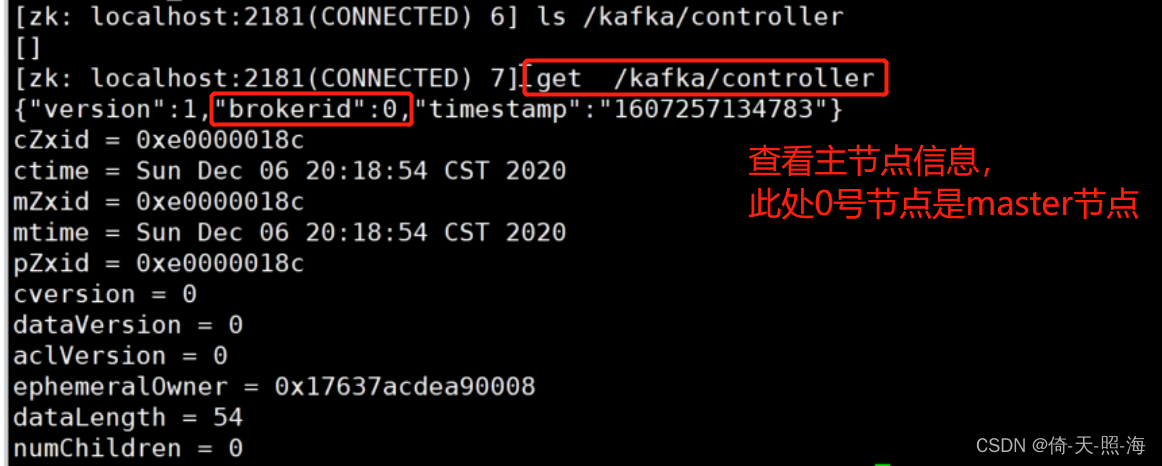
3.2、配置和启动zookeeper
Zookeeper的集群部署具体步骤见 zookeeper下载安装部署 中的集群部署zookeeper部分。
3.3、启动kafka
三个机器都要启动kafka。进入到kafka的bin目录下,启动kafka。启动之后用jps命令检查是否启动。
启动命令:./kafka-server-start.sh -daemon ../config/server.properties
# 进入到 bin 目录
./kafka-server-start.sh -daemon ../config/server.properties# 或者进入到kafka安装目录,执行如下命令
bin/kafka-server-start.sh -daemon config/server.properties3.4、创建topic
创建一个名字为testKafka的topic,有两个副本,两个分区。
--zookeeper参数表示要指定zookeeper服务的安装节点,多个节点可以用逗号分隔。并且最后加上在server.properties配置文件中zookeeper.connect属性设置的kafka启动时存储信息的路径,上面配置文件中zookeeper.connect属性配置的路径是/kafka。
命令:./kafka-topics.sh --zookeeper 192.168.1.128:2181/kafka --create --replication-factor 2 --partitions 2 --topic testKafka
./kafka-topics.sh --zookeeper 192.168.1.128:2181/kafka --create --replication-factor 2 --partitions 2 --topic testKafka3.5、启动producer和consumer
启动producer并发送消息,发送消息之后用Ctrl+C结束。
命令:./kafka-console-producer.sh --broker-list 192.168.1.128:9092 --topic testKafka
./kafka-console-producer.sh --broker-list 192.168.1.128:9092 --topic testKafka启动consumer并接受消息。按Ctrl+C结束。
命令:./kafka-console-consumer.sh --bootstrap-server 192.168.1.128:9092 --topic testKafka --from-beginning
./kafka-console-consumer.sh --bootstrap-server 192.168.1.128:9092 --topic testKafka --from-beginning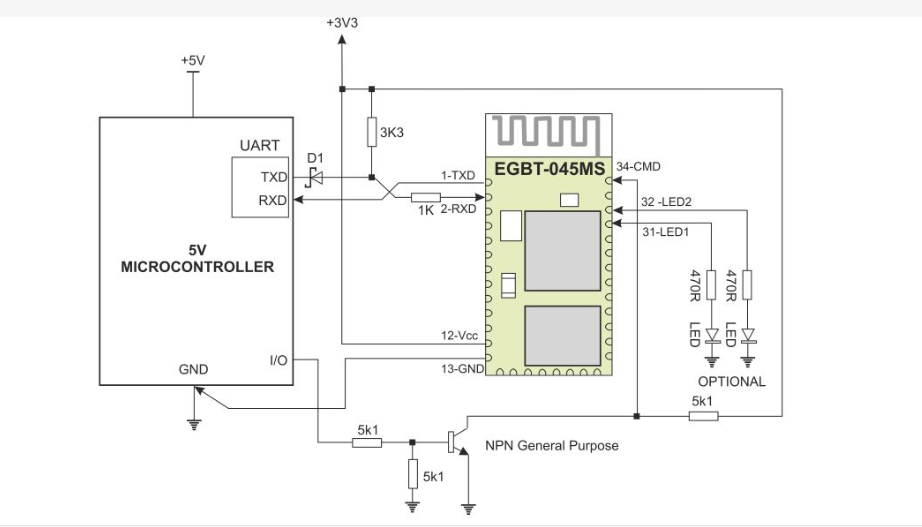

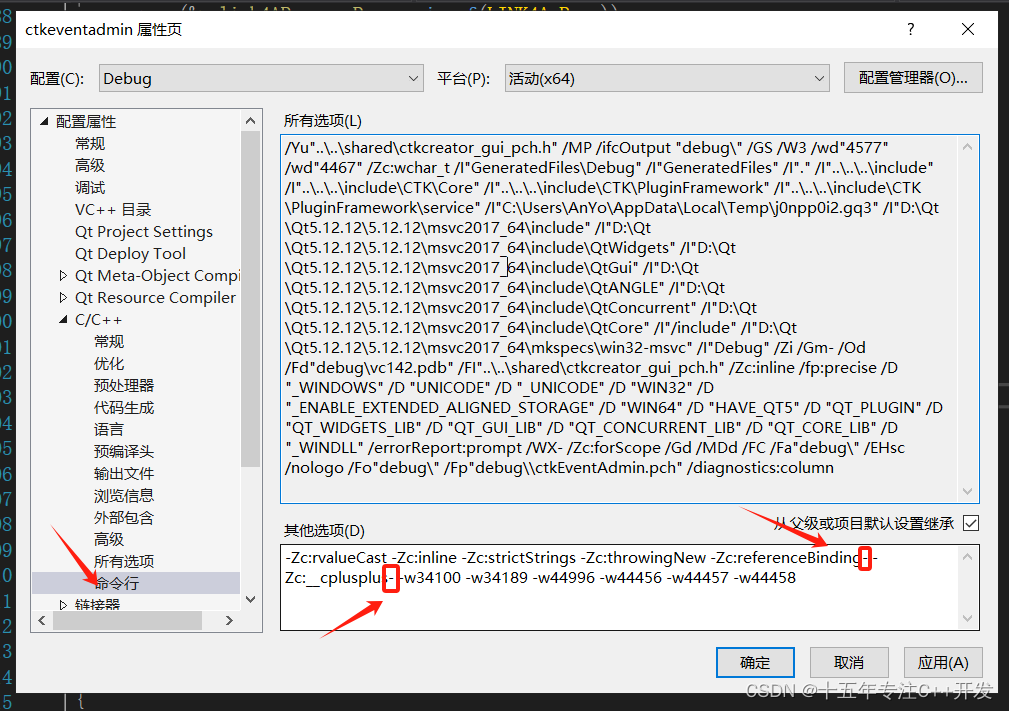

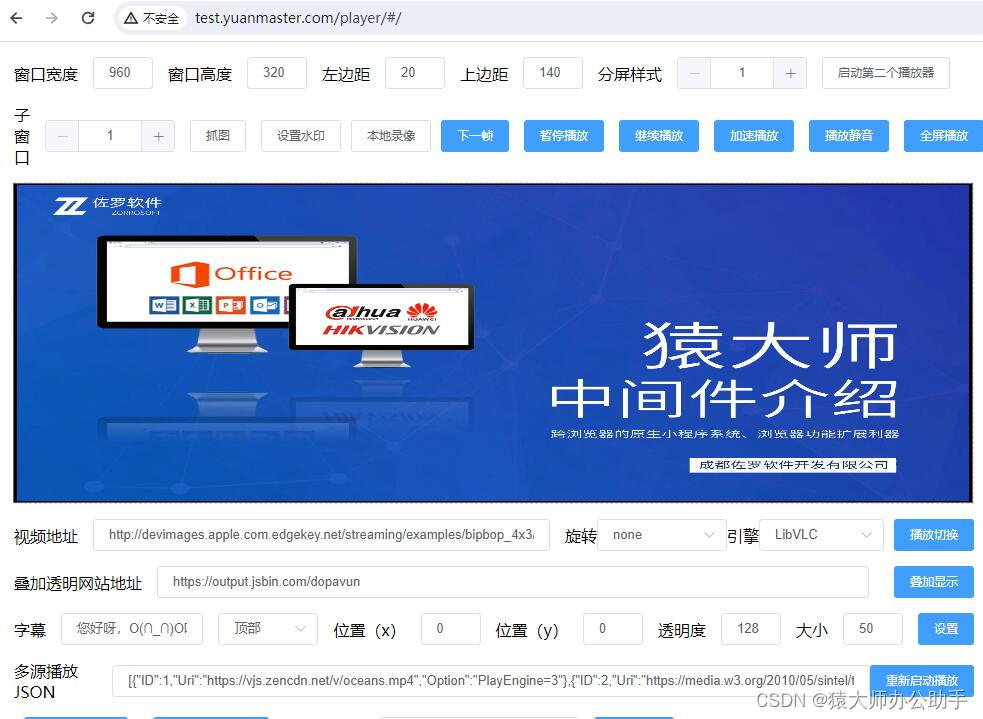





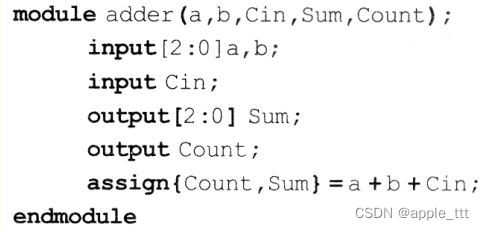

![[BJDCTF2020]ZJCTF,不过如此](https://img-blog.csdnimg.cn/direct/7eaede2b9a63415a92047e8456963cab.png)
